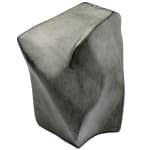-
Artworks
JOHN PANGNARK (1920-1980) ARVIAT (ESKIMO POINT)
Figure, c. 1973-4stone, 9.25 x 5.5 x 7.25 in (23.5 x 14 x 18.4 cm)
unsigned.LOT 88
ESTIMATE: $25,000 — $35,000
PRICE REALIZED: $108,00.00
A world record price for the artist at auction.Further images
Pangnark travelled further down the “minimalist” path than any of his Arviat peers, Andy Miki included. His earliest works from the mid to late 1960s were already rudimentary forms -...Pangnark travelled further down the “minimalist” path than any of his Arviat peers, Andy Miki included. His earliest works from the mid to late 1960s were already rudimentary forms - tending toward the geometric, with relatively hard edges but clearly recognizable as human. In his “middle period” (c. 1970-72) Pangnark softened and further streamlined his forms; his figures became more radically simplified but are still discernible as human. By 1973-74 his sculptures were barely recognizable as human, with only the faintest of facial details scratched onto largely abstract forms that tend to follow the original shape of the stone. As Norman Zepp writes in his 1986 catalogue Pure Vision, “...Pangnark abstracted his highly individualistic works to the point where they appear to be beyond the percipience of most collectors” [1]. George Swinton was a great admirer of the artist: “He was doubtlessly the Brancusi of the North, with a rare feeling for abstraction and for the sheer beauty of curved and hard-edged shapes” [2]. We are happy to report that many Inuit art collectors have come to appreciate Pangnark’s vision and his genius.
Elsewhere we have compared Pangnark’s lines to Matisse’s drawn lines; they suggest essential forms and leave the rest to our imaginations. We can think of no work by him that exemplifies that notion more than this splendid Figure from c. 1973-74. The sculpture’s “curved and hard-edged shapes” seem as delicate as the soft strokes of a pencil or brush. The figure is quite large and heavy by Pangnark’s standards, and yet it seems to dance as we move around it. Figure is a sensuous, even sexy sculpture with undulating contours like raw silk that virtually beg to be caressed. In our opinion, abstract sculpture simply does not get better than this. Period. Absolutely marvelous.
Of all the sculptures by Pangnark that we have researched in preparation for this catalogue, the one that comes closest in spirit and in purely formal terms is the magnificent Two Figures from c. 1972-74 (see Walker’s Auctions, Nov. 2017, Lot 93).
1. Norman Zepp, “Introduction” in Pure Vision: The Keewatin Spirit (Regina: Norman Mackenzie Art Gallery, 1986), p. 38.
2. George Swinton, “Memories of Eskimo Point 1967-1979” in Bernadette Driscoll, Eskimo Point/Arviat (Winnipeg Art Gallery, 1982:13-19), p. 14.
Literature: For Two Figures from c. 1972-74; see Walker’s Auctions, Nov. 2017, Lot 93. For a similar figure from 1974 in the Sarick Collection, see Ingo Hessel, Inuit Art: An Introduction (Vancouver: D&M, 1998), p. 126, also illustrated in Gerald McMaster ed., Inuit Modern: The Samuel and Esther Sarick Collection (Toronto: Art Gallery of Ontario, 2010), pp. xvi and 121. For important contemporaneous works by Pangnark see Sandra Dyck and Ingo Hessel, Sanattiaqsimajut: Inuit Art from the Carleton University Art Gallery Collection (Ottawa: CUAG, 2009), title page and p. 65. For a selection of important works by the artist see the section on Pangnark in Norman Zepp, Pure Vision: The Keewatin Spirit (Regina: Norman Mackenzie Art Gallery, 1986), pp. 74-85 (note especially cat. 30). For additional works by the artist see Bernadette Driscoll, Eskimo Point/Arviat (Winnipeg Art Gallery, 1982), which includes George Swinton’s essay “Memories of Eskimo Point 1967-1979.”
Provenance
Purchased in Arviat, c. 1974 by the present Private Collection, Toronto.
Join our mailing list
* denotes required fields
We will process the personal data you have supplied in accordance with our privacy policy (available on request). You can unsubscribe or change your preferences at any time by clicking the link in our emails.














